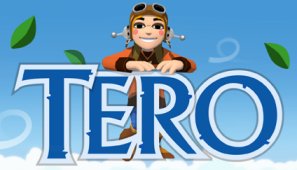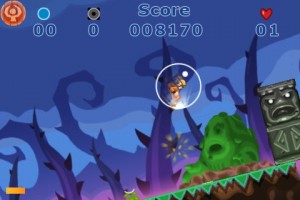 And Now For Something Completely Different
And Now For Something Completely Different
The star of Studio Yomi’s iOS debut prefers to spend his days kickin’ back and snoozing it up. He deserves the rest, because it seems everyone in need of help is after his platforming and spinning talents. You see, when you’re Tero (Out Now, $0.99), having an exasperated little dude who looks like a cross between one of Santa’s helpers and a plant burst into your home while you’re taking a nap is pretty normal. His newest assignment in hand, Tero straps on his freakish steampunk cap and heads out to rescue all the little flower-like dudes stranded in the wide world.
Tero is the kind of game you pick up when you’re interested in a good game design lesson — both for where it successfully innovates and where it trips up. It’s one of the most interesting iOS platformers by sheer virtue of its interface, which is entirely gesture-based. That’s right, no virtual buttons for movement or actions! Tilting the iDevice makes Tero run right or left, and Studio Yomi did a truly ingenious thing by making the entire in-game landscape tilt with the device, visually reinforcing the direction and magnitude of Tero’s running for the player’s benefit. Tero can pull off different moves with swipes: swipe up to jump; release and swipe back down for a stomp attack; and Tero will even pull off a neat Michael Jackson-esque spin if the player swipes down while he’s on the ground. Adding to his offensive repertoire are energy orbs and timed grenades, which respond to taps and sideways swipes respectively.
 While playing Tero‘s first set of levels, I felt like I was six and just getting used to Mario Bros. all over again; the control scheme takes quite a bit of adjustment when you’ve spent most of your gaming life reaching for buttons. Having to get used to something that felt so new made for a refreshing sense of wonder — and then the game’s second world pummeled my growing confidence right into the ground.
While playing Tero‘s first set of levels, I felt like I was six and just getting used to Mario Bros. all over again; the control scheme takes quite a bit of adjustment when you’ve spent most of your gaming life reaching for buttons. Having to get used to something that felt so new made for a refreshing sense of wonder — and then the game’s second world pummeled my growing confidence right into the ground.
I have a feeling that Studio Yomi will suffer no end of complaints about their adventurous interface, but I would argue that the UI execution is wonderfully smooth and does precisely what it’s supposed to. Tero‘s weakness lies, instead, in traditional platforming level design that simply doesn’t play on the UI’s strengths. Tilt-to-move feels great when Tero’s running over wide open ground, and even jumping over chasms as long as he has a nice landing space waiting for him on the other side. It’s telling that the game becomes insufferably frustrating only when it calls up narrow pillars and platforms, where the tilt control’s tendency for overcompensation makes every jump a nerve-wracking, near-death experience. Whether the platforming veteran loves or hates Tero may depend entirely on what level he or she is attempting at any given moment. Some are simply designed with Simon Belmont and an NES controller in mind; the ones that don’t abuse bottomless pits suit Tero’s way of doing things quite well.
While it’s difficult to imagine my feelings on Tero‘s level design changing – some of its environments would have to be entirely reconceived – I am putting one thing on my wish list for updates. In the release version, Tero temporarily loses his abilities linked to downward swipes once he’s struck by an enemy — if he gets hit, the player can’t immediately counter with a spin or a stomp to wipe out the offender. Couple that with the fact that he doesn’t seem to gain the expected period of post-injury invincibility that platforming heroes have enjoyed since time immemorial, and you’ve got one heck of a double whammy if Tero has to face an enemy on a narrow platform or in a cramped space.
 What is consistently a joy in Tero is the enemy design, where Studio Yomi scores nothing less than a home run in my opinion. Enemies might be completely invincible to or merely stunned by a certain attack approach, but vulnerable to other actions, so the player has to experiment to find what works best when new foes are introduced. Enemy behaviors vary to a satisfying degree, and boss battles waiting at the end of each world are especially interesting exercises.
What is consistently a joy in Tero is the enemy design, where Studio Yomi scores nothing less than a home run in my opinion. Enemies might be completely invincible to or merely stunned by a certain attack approach, but vulnerable to other actions, so the player has to experiment to find what works best when new foes are introduced. Enemy behaviors vary to a satisfying degree, and boss battles waiting at the end of each world are especially interesting exercises.
Tero‘s aesthetics may not stand out all that much from the competition at the get-go, but its world blooms into some very imaginative and expertly hand-drawn landscapes as the player progresses, and the music can be pretty catchy for sequenced fare. With six worlds and eighteen non-boss levels by our count, Tero should be good for five hours of gameplay — pending how much difficulty the player has with the more unfortunately designed levels.
iFanzine Verdict: Tero impresses with a smoothly executed swipe interface that makes it unique among platformers, but gives back some of its gains with level design that feels poorly suited to the interface at times. This is one that challenge-seeking platformer enthusiasts would do well to look into, as well as students of game design who feel a buck is more than a fair price for a quality hands-on lesson. But if you’re the easily frustrated type or only casually interested in platforming action games, run for the hills!
[xrr rating=3.5/5]


